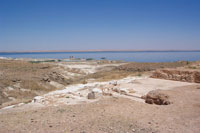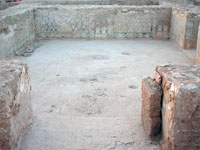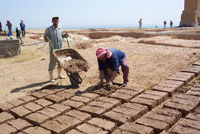The ancient islamic city of Balis had many names throughout its long history. Known as Barbalissos in hellenistic-roman and byzantine times, its roots go back to the Bronze Age city of Emar, with which it shares its location overlooking the Euphrates Valley. Excavations in the islamic layers of the site were conducted from 1998 to 1996. Unearthed structures date to Ayyubid times, around the destruction of the city by the Mongols in the 13th century AD. Due to a high and rising ground water table in connection with Lake Assad, no earlier levels could be reached. In 1998, the focus of excavations shifted to the Qasr, a palatial building dating to Umayyad times, which lies about 2 km to the south of Balis on a terrace overlooking the valley.


Finds - other that architecture - are relatively sparse, due to the fact that the site had been abandoned in an orderly fashion.
Excavations are still ongoing, and every campaign has yielded new surprises. A Website, dedicated to the Balis Excavations is currently under construction at Princeton University.

